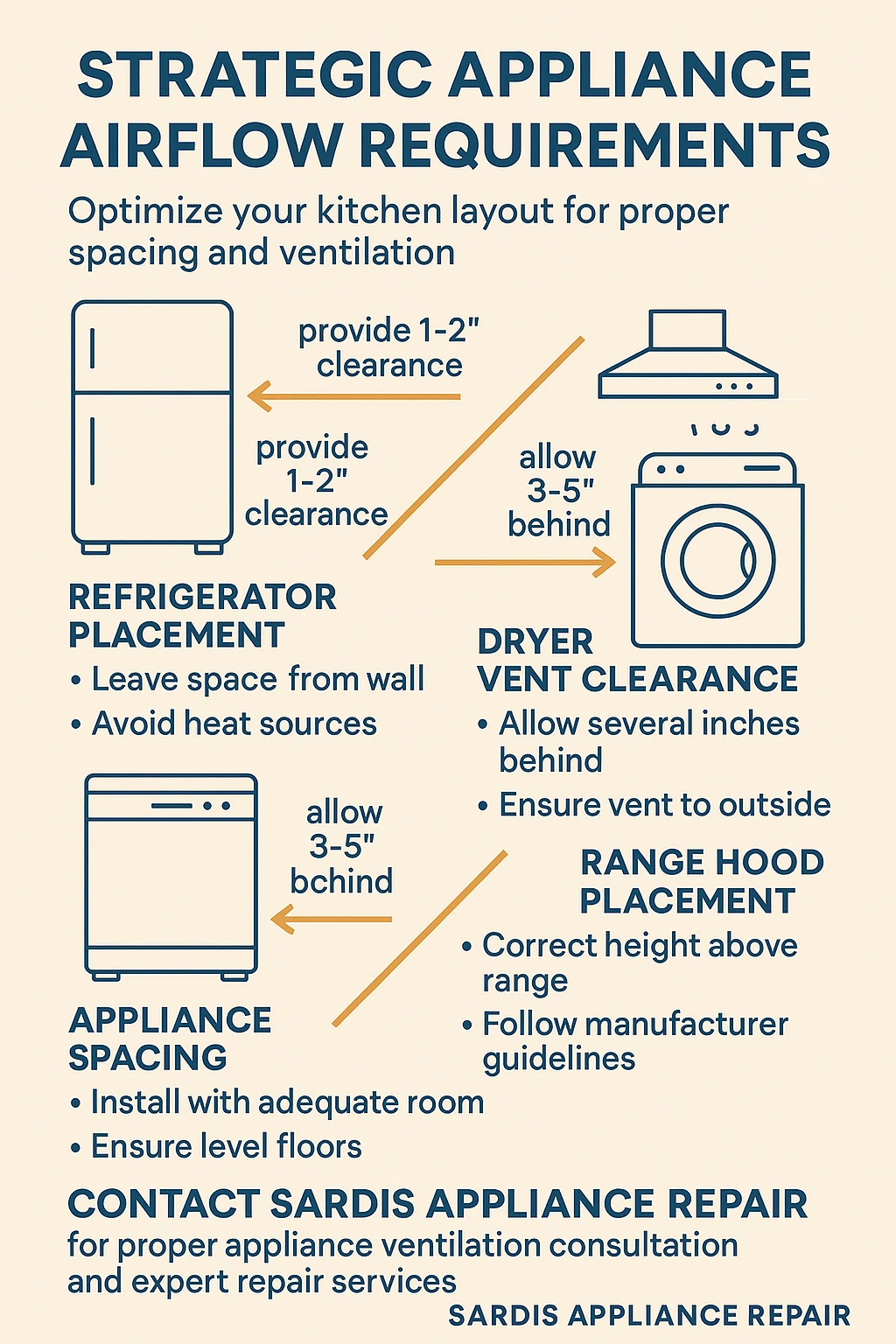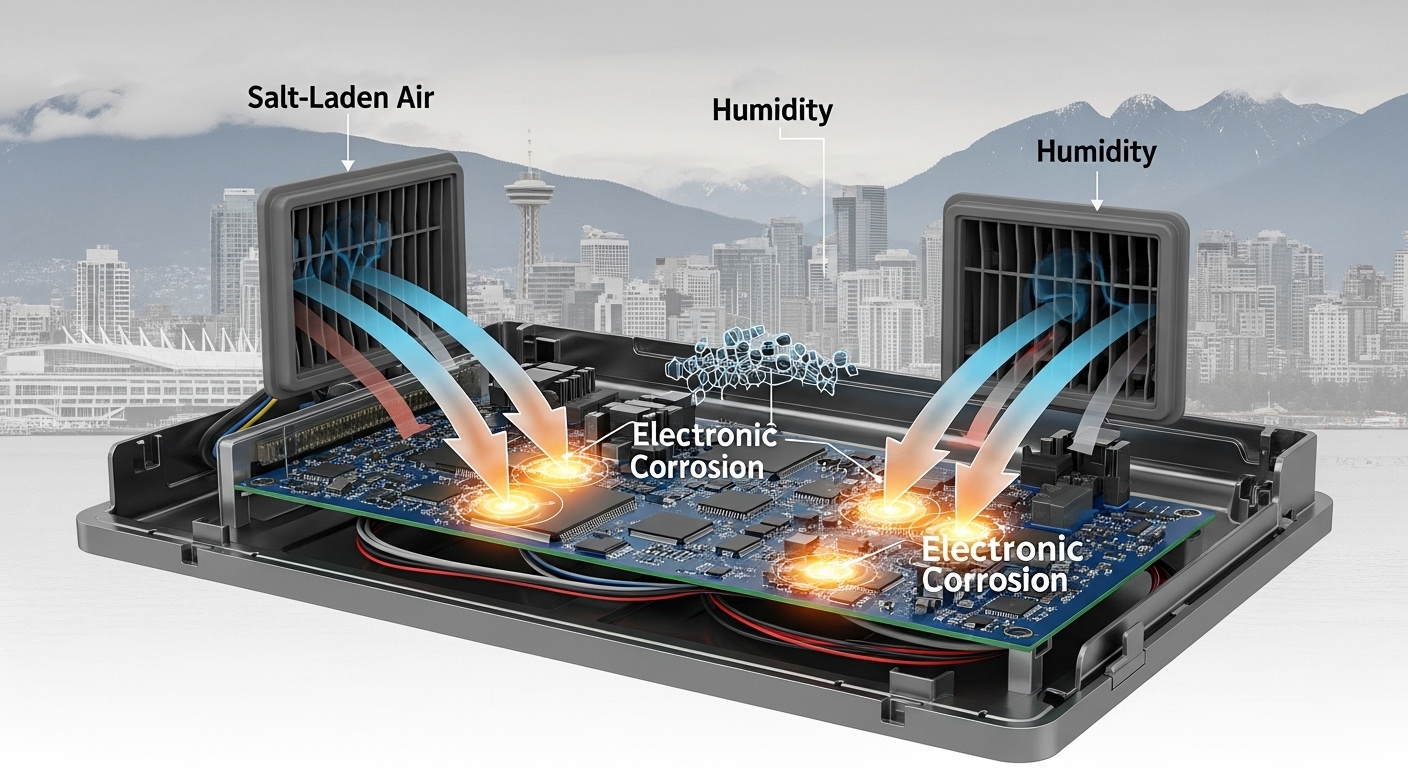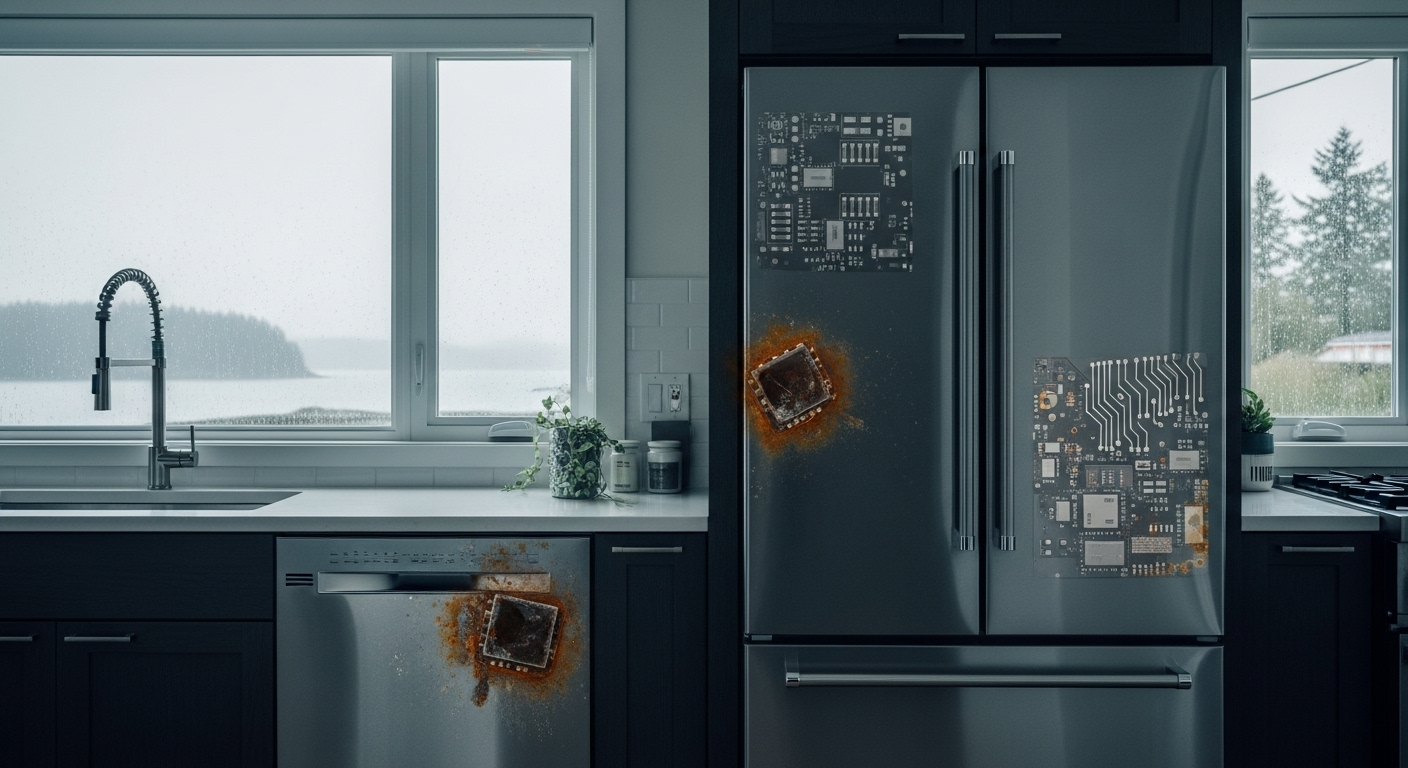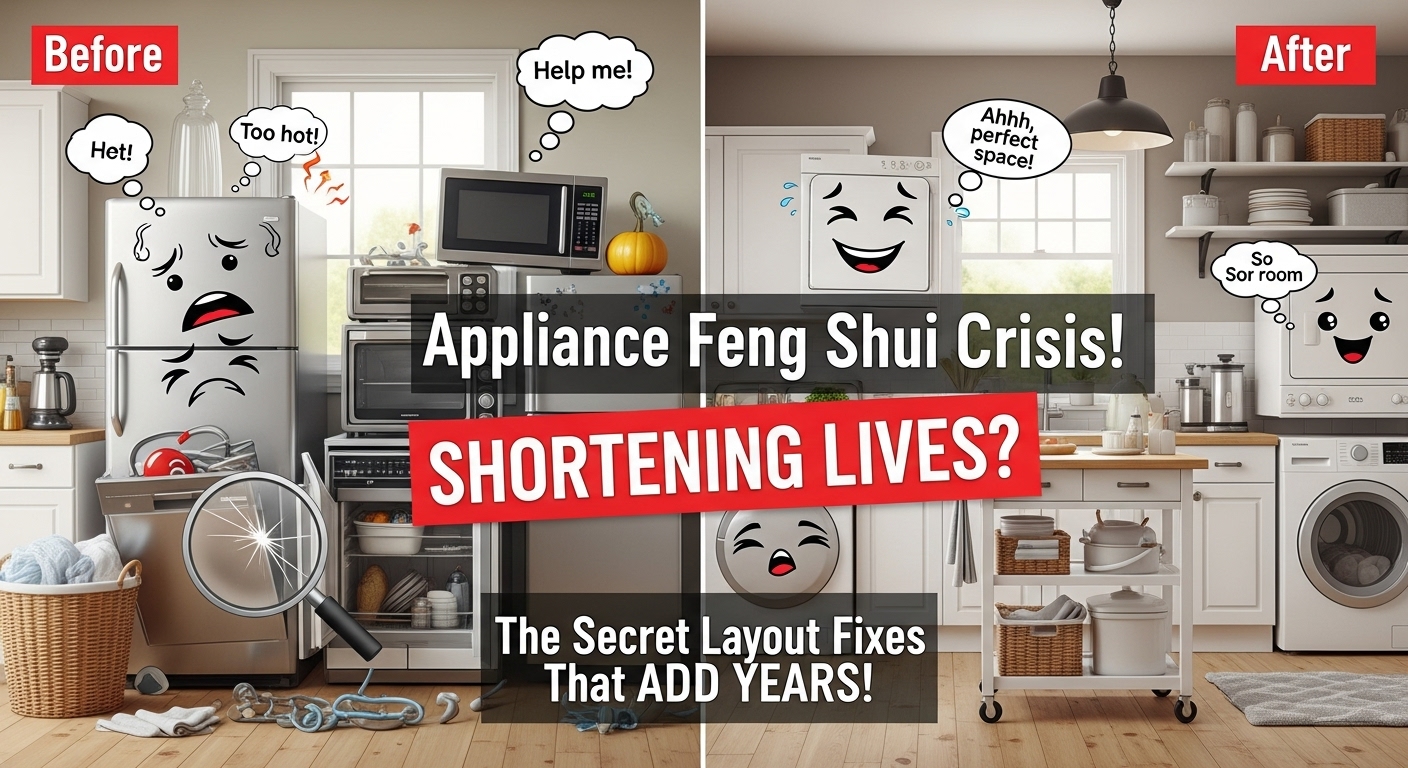Wondering why your brand-new appliances are breaking down faster than expected despite following all the maintenance recommendations? Vancouver’s unique coastal environment creates hidden placement challenges that can slash your appliances’ lifespan in half while voiding warranties you thought were bulletproof.
Picture this: you’ve just invested $15,000 in a gorgeous kitchen renovation complete with stainless steel appliances that promise years of reliable service. Six months later, your dishwasher starts leaving white residue on everything, the refrigerator compressor is working overtime with strange grinding noises, and that beautiful range hood you splurged on isn’t effectively clearing cooking odors. What seemed like isolated bad luck is actually the predictable result of Vancouver’s notorious coastal climate systematically attacking improperly placed appliances in ways that manufacturers rarely warn you about.
The harsh reality is that Vancouver homeowners face a perfect storm of environmental challenges that make proper appliance placement absolutely critical for long-term performance and warranty protection. Our city’s combination of salt-laden ocean air, persistent humidity, and dramatic temperature swings creates conditions where a refrigerator placed too close to a heat source won’t just work harder – it’ll fail catastrophically within years instead of decades. Meanwhile, installation mistakes that might cause minor inefficiencies elsewhere can void warranties entirely under BC’s strict electrical and plumbing codes.
Understanding these hidden Vancouver-specific threats isn’t just about avoiding repair bills. It’s about protecting substantial investments in home infrastructure while ensuring your family’s daily routines aren’t disrupted by preventable appliance failures. The financial implications extend far beyond simple repair costs to include energy efficiency losses, premature replacement expenses, and potential property damage from water leaks or electrical failures that often result from poor placement decisions made during installation.
Key Outtakes
- Vancouver’s coastal environment accelerates appliance component corrosion and electronic failures at rates up to 40% higher than inland cities due to salt air penetration and humidity infiltration
- Installation mistakes void more warranties than actual product defects, with electrical connection errors accounting for nearly 40% of rejected warranty claims in the Vancouver area
- Smart appliance repairs often cost upwards of $350 compared to around $175 for traditional appliance repairs due to complex diagnostic requirements and specialized components
- Proper appliance placement following Vancouver-specific guidelines can extend equipment lifespans by 3-5 years while preventing 80% of common environmental failures
- Professional installation becomes mandatory for warranty protection, as manufacturers increasingly require certified technicians to honor coverage under BC’s strict building codes

Vancouver’s Coastal Climate Creates Unique Appliance Threats

Vancouver’s position between the Pacific Ocean and the Coast Mountains creates environmental conditions that distinguish it from virtually every other major Canadian city when it comes to appliance longevity. The persistent salt air doesn’t just affect outdoor equipment – microscopic sodium chloride particles infiltrate homes through normal ventilation systems and gradually accumulate within appliance components where they initiate aggressive corrosion processes. This salt penetration reaches surprisingly far inland, with homes in Richmond, Burnaby, and even parts of Surrey experiencing accelerated appliance wear that catches homeowners completely off guard.
The science behind salt-induced appliance damage involves electrochemical reactions that occur when sodium chloride deposits come into contact with moisture and different metal components within your equipment. Unlike simple surface rust that you might wipe away, this corrosion attacks internal wiring, circuit boards, and mechanical connections where repairs become prohibitively expensive. The process accelerates dramatically in Vancouver’s high-humidity environment, where moisture provides the perfect medium for these destructive chemical reactions to occur continuously rather than just during obvious weather events.
Temperature fluctuations unique to our coastal climate create additional stress patterns that gradually compromise appliance integrity through repeated expansion and contraction cycles. While other Canadian cities experience predictable seasonal changes, Vancouver’s weather patterns subject kitchen and laundry equipment to constant thermal cycling that causes rubber seals to develop micro-cracks, metal joints to loosen, and plastic components to become brittle over time. These seemingly minor changes accumulate until they result in sudden, catastrophic failures that often occur just outside warranty periods.
The city’s microclimates compound these challenges in ways that many homeowners never consider when making placement decisions. Properties near False Creek experience urban heat island effects that stress cooling appliances, while North Shore homes deal with elevation-related pressure changes that affect sealed systems. Meanwhile, Fraser River proximity in Richmond creates unique humidity patterns that can overwhelm standard appliance drainage systems, leading to mold growth and component degradation in locations where manufacturers never anticipated such conditions.
Kitchen Appliance Placement Disasters That Void Warranties

The kitchen represents the most expensive appliance concentration in any Vancouver home, making proper placement decisions critical for both performance and warranty protection. Understanding the specific clearance requirements and environmental considerations becomes even more important when you realize that installation mistakes void more warranties than actual manufacturing defects, particularly under BC’s strict electrical and building codes that exceed standards in many other provinces.
Refrigerator placement errors rank among the most costly mistakes Vancouver homeowners make, often stemming from a fundamental misunderstanding of how these appliances manage heat rejection in our challenging climate. Placing a refrigerator within 24 inches of an oven, dishwasher, or direct sunlight forces the cooling system to work significantly harder to maintain proper temperatures. In Vancouver’s humid environment, this additional workload doesn’t just increase energy consumption – it creates internal pressure conditions that can cause compressor failure within 3-5 years instead of the expected 12-15 year lifespan. The proper clearance requirements specify minimum 15-inch spacing from heat sources, but many contractors treating this as a suggestion rather than a warranty requirement.
Range hood installation represents another critical area where Vancouver’s building codes intersect with appliance performance requirements in ways that create warranty vulnerabilities. Indoor range hoods must be mounted 28-36 inches above cooktop surfaces for optimal capture efficiency, while outdoor installations require 36-42 inches due to different airflow patterns. However, the more serious warranty issue involves electrical connections that don’t meet BC Electrical Code requirements for amperage and circuit protection. Many beautiful range hoods fail prematurely not because of mechanical problems, but because inadequate electrical installations cause power quality issues that damage sensitive control systems.
Counter landing area violations might seem like minor design oversights, but they create functional problems that often lead to appliance damage through normal daily use. Kitchen design guidelines require specific spacing around major appliances – 15 inches on the handle side of refrigerators, 24 inches on one side of sinks, and adequate clearance for dishwasher doors to open without interfering with other cabinetry. When these requirements aren’t met, homeowners develop workaround habits that stress appliance components beyond their design parameters, leading to premature failures that manufacturers can legitimately blame on improper installation or usage patterns.
Smart appliance placement introduces entirely new categories of warranty considerations that many Vancouver homeowners discover only after problems develop. These connected devices require stable electrical power, reliable internet connectivity, and specific environmental conditions that traditional appliances never needed. Vancouver’s aging electrical infrastructure creates power quality issues that can damage smart appliance electronics, while our dense urban environment generates WiFi interference that prevents proper communication with manufacturer servers required for warranty support and remote diagnostics.
Ventilation Failures That Create Expensive Problems

Proper ventilation represents one of the most misunderstood aspects of appliance placement in Vancouver homes, where our climate creates moisture management challenges that exceed what most equipment was designed to handle. The combination of persistent rainfall, elevated humidity, and temperature fluctuations means that inadequate ventilation doesn’t just affect comfort – it creates conditions where mold, condensation, and poor air circulation systematically destroy expensive appliances from the inside out.
Laundry room ventilation mistakes top the list of costly oversights that Vancouver homeowners make during renovation projects. Dryer vent installations must follow specific guidelines that become critical in our wet climate: maximum duct runs shouldn’t exceed 25 feet, with 2.5 feet subtracted for each 45-degree turn and 5 feet for each 90-degree turn. However, the more serious problems occur when contractors use flexible plastic or foil ducts that can be easily kinked or crushed, restricting airflow and creating fire hazards. In Vancouver’s humid environment, these restrictions also cause moisture to back up into the dryer itself, leading to mold growth and component corrosion that voids warranties while creating health hazards.
The temptation to vent dryers into basements, crawl spaces, or attics becomes particularly dangerous in Vancouver’s climate where that expelled moisture has nowhere
 (604) 305-2992
(604) 305-2992 
 Schedule An Appointment
Schedule An Appointment 
